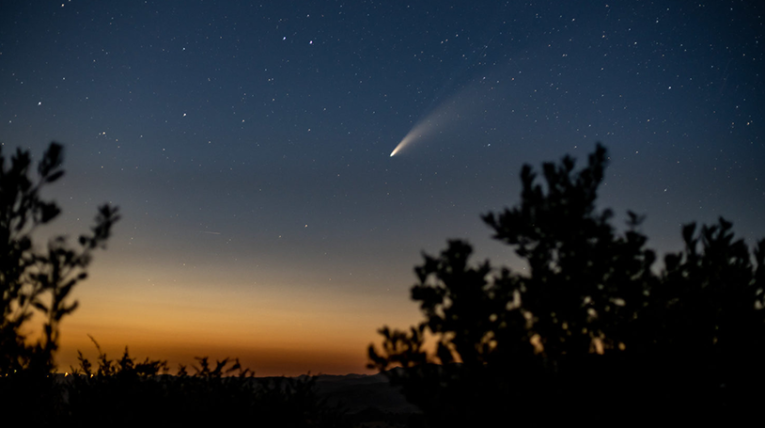Earth, with its familiar seasons, may seem straightforward, but the same cannot be said for other planets. While we cherish Earth’s uniqueness, it is equally important to explore the wonders of other worlds. Welcome to the cosmic dance of the seasons of Uranus! Unlike our familiar Earthly cycle, Uranus spins with its own rhythm, offering a spectacle of changing seasons of Uranus that defy expectations. In this blog, we’ll delve into the captivating world of Uranus and its seasonal shifts, unravelling the mysteries that the seasons of Uranus hold. So, fasten your seatbelts as we embark on a journey through the ever-changing climate of the seventh planet.
Discovery of Uranus
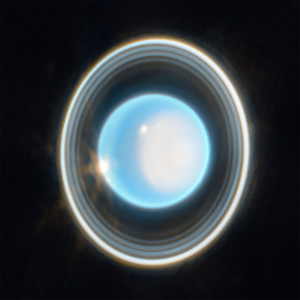
Credits: JWST/NASA/ESA
Uranus holds the distinction of being the first planet discovered with the aid of a telescope. Positioned as the seventh planet from the Sun, alongside Neptune, it is classified as an ice giant. Discover more about the intriguing revelation of Uranus and its distinctive attributes. Ready to explore the mythological tales of Uranus? Click here to embark on a captivating journey!
Rotational Tilt of Uranus
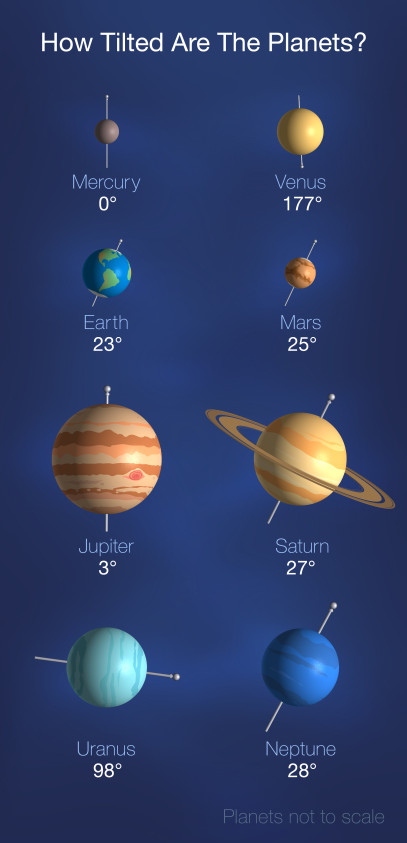
It is common knowledge that every planet rotates on its axis, which leads to day and night. However, this axis of rotation is usually at an angle from the normal, except for Mercury. The Earth’s rotational axis is inclined at an angle of 23.5 degrees.
While most of the planets make a small angle to the normal, Uranus exhibits a bizarre rotational axis, making an angle of ~98 degrees, making it rotate along a horizontal direction when compared to Earth’s rotation. The rotation of Uranus is similar to the ‘rolling of a ball’. This rotational tilt is what causes the bizarre seasons of Uranus.
Want to know the reason behind such an extreme tilt of the Uranus? Click here to find out!
Bizarre Seasons of Uranus
Uranus, with its distinct tilt of 98 degrees, experiences some of the most peculiar seasonal dynamics in our solar system. Unlike the relatively modest tilt of Earth’s axis, which gives rise to our familiar seasonal changes, Uranus’ extreme tilt means that its poles are virtually perpendicular to its orbital plane.
This tilt essentially causes Uranus to roll around the Sun on its side as it orbits, leading to remarkable and lengthy seasonal variations, or the bizarre seasons of Uranus.
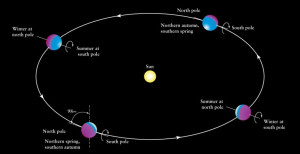
Image Credits: Arizona State University
The most striking aspect of seasons of Uranus is their duration. Given its slow orbital period of approximately 84 Earth years, each of the four seasons of Uranus lasts for a staggering 21 Earth years. This extended duration is unparalleled in our solar system and dramatically shapes the climate and conditions on the planet.
During Uranus’ summer season, one of its poles, along with a significant portion of the corresponding hemisphere, is bathed in continuous sunlight for an entire 21-year period.
This results in an enduring polar day, where the sun never sets, and temperatures soar to extreme levels. Meanwhile, the opposite pole and its hemisphere plunge into a prolonged polar night shrouded in darkness.
Conversely, Uranus’ winter season sees a reversal of these conditions, with the pole that previously experienced continuous daylight, enduring an extended period of darkness, while the opposite pole enjoys an extended period of daylight.
This cyclic transition between polar days and nights creates dramatic shifts in temperature and atmospheric conditions across the planet.
The transitions between seasons of Uranus, such as spring and fall, are equally remarkable. During these transitional periods, sunlight is distributed evenly across the equatorial region, leading to milder temperatures compared to the extremes experienced at the poles.
However, even during these seasons, Uranus’ unique day-night cycle, which lasts approximately 17 hours and 14 minutes, continues to influence the planet’s climate and weather patterns, and thus the seasons of Uranus.
Uranus’ unconventional tilt gives rise to some of the most extraordinary seasonal variations observed in our solar system. From the enduring polar days and nights to the more temperate equatorial regions, each season on Uranus presents a fascinating spectacle of planetary dynamics, offering valuable insights into the diversity of worlds beyond our own.
Climate on Uranus
Uranus’ climate is significantly impacted by two key factors: its limited internal heat, which restricts atmospheric activity, and its extreme axial tilt, which leads to pronounced seasonal changes.
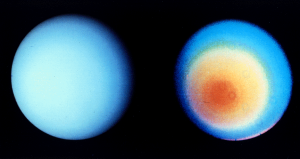
Credits: NASA Goddard Space Flight Center
Compared to its gas giant counterparts, Uranus possesses a relatively uneventful atmosphere. During Voyager 2‘s flyby in 1986, only ten cloud formations were observed across the entire planet.
Ever wondered how spacecraft conquer immense distances? Find out in this captivating video!
Subsequent ground-based and Hubble Space Telescope observations in the 1990s and 2000s revealed the presence of bright clouds in the northern hemisphere, particularly during its winter season. Additionally, in 2006, a dark spot akin to Neptune’s Great Dark Spot was identified on Uranus.
Astronomers recently achieved a groundbreaking feat by uncovering Uranus’ infrared aurora using archived data from the Keck II telescope in Hawaii. Similar to Earth’s auroras, Uranus’ auroras are formed when charged particles from the solar wind interact with the planet’s magnetic field, funnelling towards its magnetic poles.
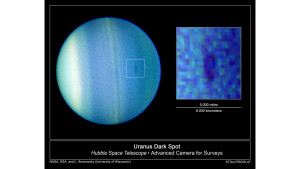
Credits: NASA/ESA, STScI,
Do you find Northern lights Fascinating? Check out our Blog on this Nature’s Masterpiece
However, due to Uranus’ atmospheric composition—predominantly hydrogen and helium at lower temperatures—the auroras emit mainly in ultraviolet and infrared wavelengths. While NASA’s Voyager 2 first detected the ultraviolet aurora in 1986, it took nearly four decades to identify its infrared counterpart.
Analyzing data from the Keck II Near-Infrared Spectrometer, researchers, led by graduate student Emma Thomas, unveiled emission lines from the H3+ molecule, shedding light on the mechanisms driving Uranus’ auroras.
This discovery also raises intriguing questions about the planet’s magnetic field misalignment with its rotational axis, offering potential insights into Uranus’ atmospheric and magnetic dynamics.
Wondering about upcoming missions to explore Uranus? Here’s a glimpse at the missions NASA has planned to investigate the cyan-coloured planet.
Locating Uranus in Night Sky
Prepare for an extraordinary cosmic experience as we unravel the mystery of locating Uranus, the elusive seventh planet, amidst the dazzling spectacle of the night sky.
Uranus, the seventh planet from the Sun, offers a captivating sight in the night sky for those with a keen eye. However, due to its considerable distance from Earth and its faint appearance, observing Uranus requires specific conditions and minimal light pollution.
For observers in the Northern Hemisphere, the autumn and winter months provide the best opportunity to spot Uranus as it reaches its highest point in the sky. During these seasons, the planet is ideally positioned for viewing during the late evening and early morning hours.
In contrast, Southern Hemisphere observers enjoy better chances of sighting Uranus during the spring and summer months, typically from November through March, when the planet is at its peak in the sky.
Spotting Uranus amidst the stars requires patience, as it appears as a faint, bluish-green dot against the backdrop of the night sky. Using a telescope or binoculars can significantly enhance visibility, allowing observers to discern its small, disk-like appearance and perhaps even glimpse its faint rings.
Before you buy a telescope, discover these 9 essential things you need to know!
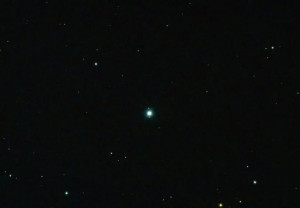
Curious about locating Uranus in your area? Dive into detailed information on when and where to spot Uranus in the night sky, particularly from locations like Mumbai, India.
Still facing challenges in locating Uranus? Don’t fret! Download the Stellarium app for assistance, and experience its celestial beauty firsthand with Stargazing Mumbai. Happy stargazing!
Uranus’s unique tilt generates remarkable seasonal variations, making it a captivating subject of study in our solar system. Its sideways rotation around the Sun results in prolonged polar days and nights, offering unparalleled insights into planetary dynamics and climate systems.
Exploring Uranus unveils the mysteries of the surprising seasons of Uranus, from enduring twilight at its poles to temperate equatorial regions. Each of the seasons of Uranus presents a distinctive spectacle, enriching our understanding of celestial diversity and planetary evolution.
The cosmic dance of the changing seasons of Uranus reveals its stunning beauty and complexity. Its azure atmosphere and intricate cloud pattern mesmerise observers, inspiring awe and curiosity about the universe.
Hopefully, you found this exploration of the seasons of Uranus fascinating! If you have any questions or insights to share, we’d love to hear from you. Feel free to leave a comment below and continue the discussion.
Consider reading: Solar System – It Is Not Only All About 8 Planets 9 Amazing Things To Know About The Jupiter
